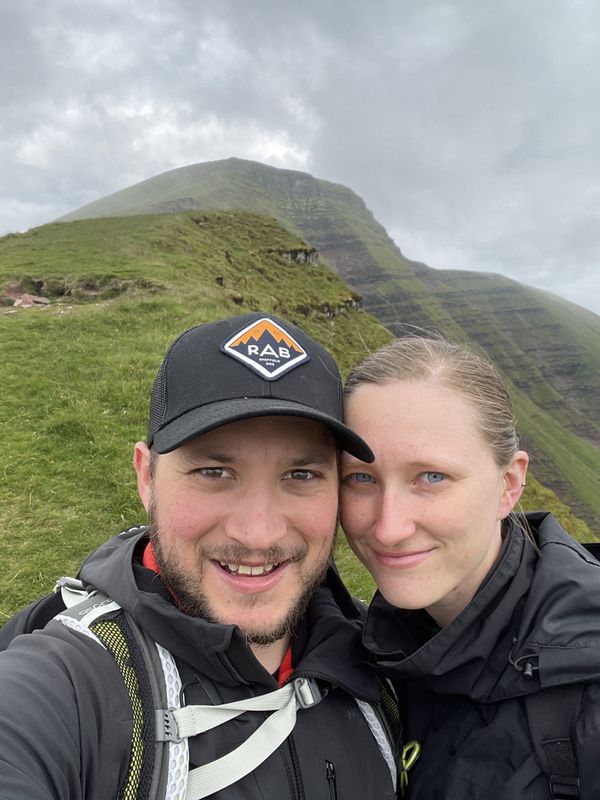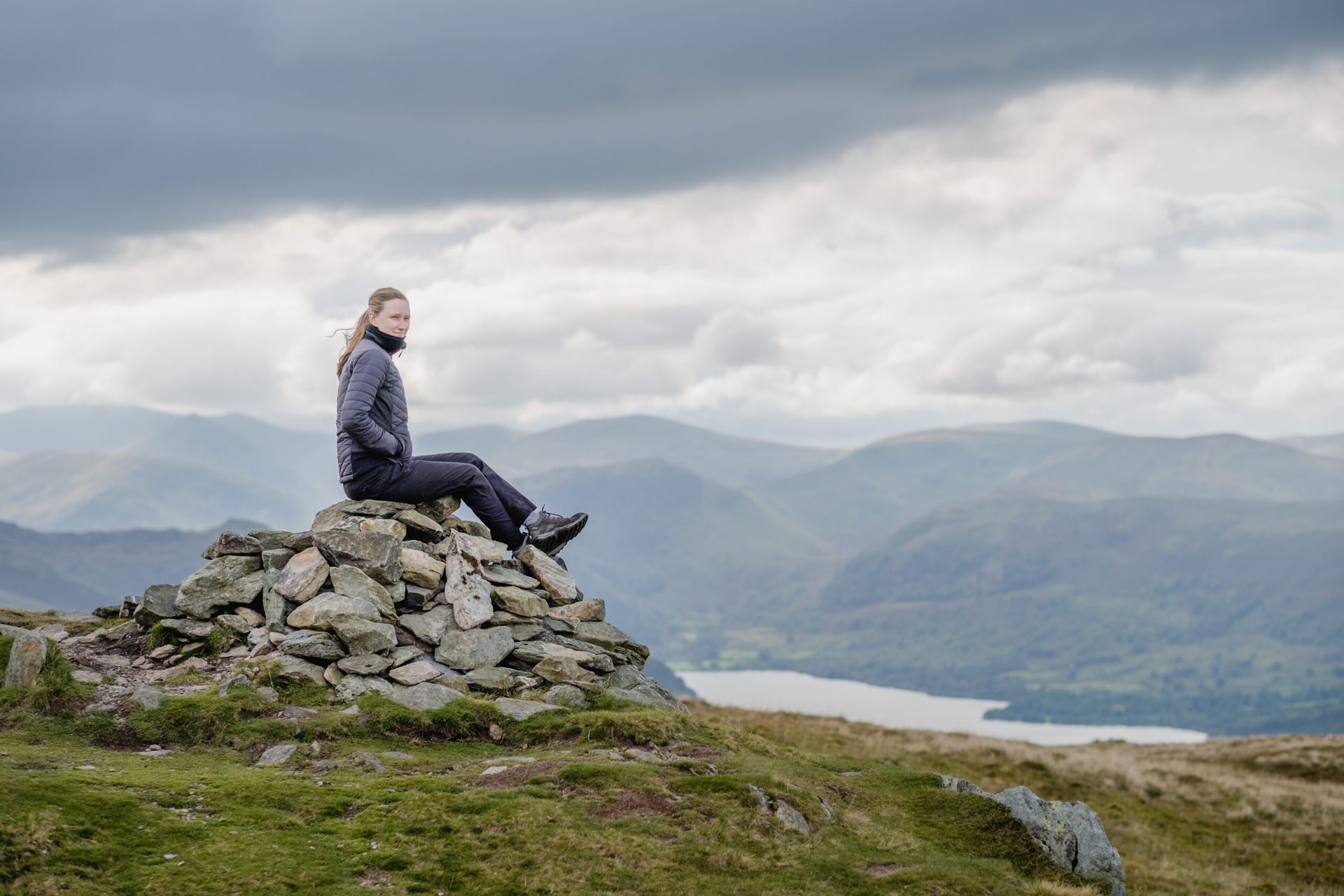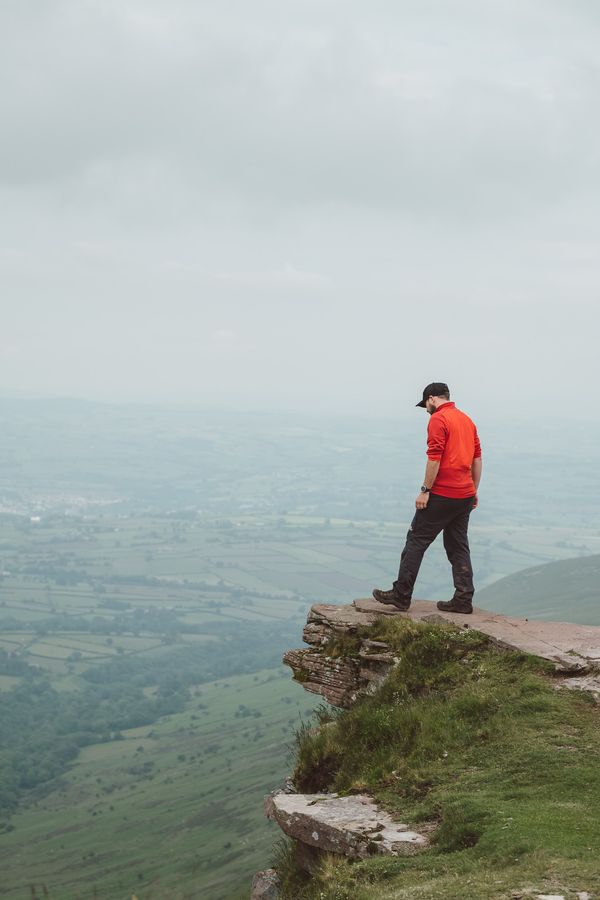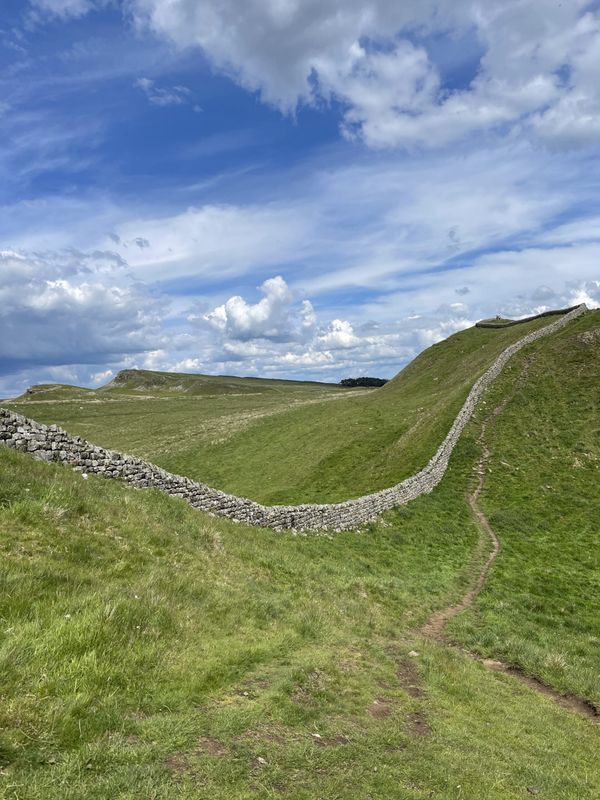No matter your ability, there are so many fantastic walking and hiking routes all over the UK! We love a hike that’s just the right amount of challenging, gives us picturesque countryside views, while leaving us with a real feeling accomplishment when we put our aching feet up at the end of the day. Whether you’re hitting the trail to challenge yourself, you’re chasing the spectacular summit view, or just looking for a picturesque hike, here’s 6 of our favourite hikes we’ve completed in the UK.
Table of Contents
Snowdon, Snowdonia, Wales
Beginning with the highest mountain in Wales, Snowdon has 6 different paths to reach the summit making it one of the more accessible mountains to climb, as you can tailor your route to your ability. However, the hike should not be underestimated and it’s important to be prepared both in gear and attention to the weather – more on both in the footnote below.
We recommend following the Pyg trail for the ascent, and the Miners track on the way down – you’ll have a steady but beautiful climb up, and a steep descent that levels out, so you can enjoy a gentle end to your hike. This route took us around 3.5 hours, with a few short breaks to admire the views and top up our energy with snacks! Choose a clear day to hike Snowdon and you’ll be rewarded with panoramic views over the lakes and mountainside below, plus you’ll have a perfect photo opportunity when you reach the trig point at the summit!
Difficulty: 2/5. There’s the option to take the more gentle trails with easy footing, a hike that caters to all abilities.
Pen Y Fan horseshoe ridge, Brecon Beacons, Wales
Pen Y Fan stands at 886 metres, and by choosing the horseshoe ridge route you’ll also scale Corn Du, Cribyn and Fan Y Big on a 16km loop. Pen Y Fan and the land around it are owned and maintained by the National Trust, meaning the paths are well-managed – even if they do wind along cloud-height mountain ridges! It took us just under six hours of hiking (with plenty of photo and snack breaks) to complete the route, so if you’re looking for a shorter route you might try starting at the Pont ar Daf car park at the bottom of Corn Du, and walking up to Pen Y Fan from there – this route takes just over an hour to reach the summit from the car park. Because this area sees more footfall, the ridge has sturdier paths with purpose-built stone pathways and wooden handrails to help those climbing Pen Y Fan.
For the horseshoe route though, expect jagged stone paths, a steep ascent onto the ridge, and exposure to the elements as you follow a ridge with steep drops on either side where you’ll have to take things slowly and carefully. That being said, a slow and steady pace gives you the opportunity to appreciate the panoramic views all around! This hike was incredibly strenuous, even for avid hikers like ourselves, and it’s not one we went into lightly. There are a lot of loose stones and in parts you’ll have to scramble over rocks, so we’d recommend starting this hike early in the day to account for the route taking longer than you might think.
Difficulty: 4/5. Takes most of a day to complete the route, there’s exposure to the elements at that elevation, and some steep ascents and loose terrain.
Isle of Portland coast path, Dorset, England
This 21km circuit following the coastal path around Portland is part of the South West Coast Path route. We decided to hike this footpath purely for the fun of being able to say we’d hiked around an entire island, though what makes this route special is all the beautiful and varied sights you’ll see along the way. Portland Bill lighthouse, with its distinctive red and white stripes, sits at the most southerly point of the island where the wind can be particularly fierce! There’s also the partially ruined Rufus Castle – one of three buildings on Portland with Grade I listing – and many secluded beaches along the southeast side of the island, lined with cute beach huts, that make perfect stopping points to sit and admire the sea views.
The hike took us around 4.5 hours, not including all the times we stopped to snap photos as there were more stunning sights around every corner! In Spring and Summer months, the old quarry is filled with flora and butterflies soaking up the sunshine, basking on an array of carved stone animals in the sculpture park. Portland is also said to be one of the most popular spots for rock climbers in the whole South West of England, so you might be able to spend some time watching them scale the impressive rocky landscape of the island. We hiked the path in Winter and were treated to a gorgeous dusky pink sunset over the harbour as we closed the loop on our hike. For animal lovers, you may spot the resident wallabies as you pass Fancy’s Farm! All in all, hiking the route makes for a fun day out and the variety of sights will help entertain little ones along the way.
Difficulty: 1/5. Despite initial steep ascent onto the clifftops, lots of signposts make the path easy to follow, and there’s various points of interest to stop at for a rest if needed.
Hadrian’s Wall Path, North England
This is the number one multi-day hike we recommend to everyone! The official Hadrian’s Wall Path runs across Northern England for 117km beginning in Wallsend, North Tyneside, and ending in Bowness-on-Solway on the coast, just West of Carlisle. We chose to add an extra 12km to our hike and begin at Long Sands beach in Newcastle, to make our hike a coast-to-coast route! We allocated 7 days to hike the Hadrian’s Wall Path, and in the planning stages we decided how far we’d walk each day mainly around the availability of accommodation along the way. Throughout some parts of the trail you’ll find accommodation surprisingly scarce, and other parts are more undulating than others – both elements to consider when planning your distance each day.
This historic route has so much to offer anyone who takes on the challenge, from gaining a real insight into Roman life, to the stunning scenery as you hike through the British countryside. The route is well-trodden and incredibly well signposted, making it a pleasant hike – albeit a long one! It’s a fantastic challenge and an experience we cherish, and as such we’ve written extensively about our time hiking the trail! Read more about our Hadrian’s Wall Path experience in the posts below:
- Hiking Hadrian’s Wall – what you need to know
- Hiking Hadrian’s Wall – our full seven day itinerary
- The highlights of hiking the Hadrian’s Wall Path
- Where to stay along the Hadrian’s Wall Path
Difficulty: 3/5. Rating based on completing the full route in one trip, with seven days of continuous hiking over undulating land. A pleasant trail that can be made even easier if completed in sections.
Quiraing, Isle of Skye, Scotland
The unusual landscape on the Isle of Skye makes it a fantastic destination for hiking! The landscape around Quiraing was shaped by an ancient landslide, making for oddly-shaped mountains and picturesque viewpoints. Quiraing is the only part of the slip that is still moving – a road at the base requires repairs every year! During this 7.5km hike, we were treated to beautiful views as we scaled the narrow path winding up the hillside, where the landscape could be taken straight from a scene Lord of the Rings, before arriving at the dizzying summit for panoramic views over the mountains, beaches and sea below.
As beauty spots on the Isle of Skye have become increasingly popular tourist destinations in recent years, hiking routes here are often underestimated by less experienced walkers who are looking for a nice photo opportunity. While this hike is one of the shortest on our list, the terrain can make it a gruelling one for those who arrive unprepared. On our descent back to the car park at the base of Quiraing, we were unfortunate enough to witness a walker being taken on a stretcher into the back of an ambulance, having slipped and seriously injured themselves. Read on for our footnote about gearing up for a hike, no matter the difficulty or length.
Difficulty: 3/5. Some challenging, steep terrain, and exposure to the elements due to Quiraing’s proximity to the coast.
South Downs Way, South England
Running 160km through the South Downs National Park, the South Downs Way takes you all the way from Eastbourne in the East to Winchester in the West, typically taking 7-9 days to complete in one trip. Unlike the Hadrian’s Wall Path, we chose to hike the South Downs Way in sections over time due to the more varied, undulating landscape and lack of accommodation right on the trail. Where B&Bs and campsites on the Hadrian’s Wall Path tend to be either a short detour from the route or sitting right on the path, accommodation along parts of the South Downs Way require coming miles off the route. This turned out to be a blessing as we were in dire need of a decent rest after spending the first day hiking over the Seven Sisters!
The highest point on the route is at Butser Hill in Hampshire, at 271 metres. You’re guaranteed spectacular views, and it’s a popular spot for paragliders setting off over the hillside. There are plenty of benches here to sit and take the weight off your feet while you watch them glide. One of our favourite points on the South Downs Way is the equally stunning Ditchling Beacon – the highest point in East Sussex at 248 metres. You’ll need to consider how the elevation at these points on the route will affect conditions, as high winds and rain come lashing over the Downs in inclement weather. Being such a long trail, of course you can expect that the terrain and elevation are very mixed, but this makes completing the route all the more rewarding! You can read more details of sections of the South Downs Way on our Walks page.
Difficulty: 2/5. Mostly flat, long paths along the South Downs with villages breaking up the hike and providing rest stops. Some strenuous and exposed sections, much easier to complete in stages rather than in one trip.
A note on preparation, gear, and weather
A few important points to help you plan a smooth and stress-free hike, no matter how far you’re walking!
- Training. Depending on the hike, you might consider getting in some training ahead of your trip. Whether you need to get used to carrying a large backpack, or simply need to increase the length of time that you feel comfortable hiking for, a few practice hikes will help you feel prepared to take on your challenge, whatever it may be!
- Wear sturdy shoes. So many times we’ve been on strenuous hiking trails and passed other walkers in Converse trainers or street shoes with absolutely no grip. These might be comfortable enough for a couple of hours on flat ground, such as some sections of the South Downs Way, but for a longer or more challenging route you’ll need good quality hiking boots that you’ve already broken in. Nobody wants to be hobbling along a trail applying plasters to blistered feet, or worse, slipping on loose rocks and injuring yourself as you attempt to scale Pen Y Fan or Quiraing. On those paths, at that height, a small slip can become dangerous really quickly.
- Choose a comfortable backpack. This one’s equally important for long hikes where you’ll be carrying more gear. We’ve invested in two sturdy backpacks with padded straps so we can comfortably carry our belongings between us on long hikes. Choose a backpack with compartments that are easy to get into so you can quickly access items when needed. Which brings us to…
- Consider what gear is essential. For multi-day hikes, you’ll want to prioritise items that will make your life easier when you’re facing long days of hiking – think good quality clothes that fold into tiny spaces, travel-sized toiletries, and lightweight camping items. You might consider going on a practice hike in the weeks before a multi-day hike, as we did before taking on the Hadrian’s Wall Path – we chose a four hour loop over mixed terrain with our backpacks full of everything we’d need to hike the Path. This was helpful in knowing what items we needed easier access to in our backpacks, understanding the importance of taking breaks to take the weight off your feet even if just for a few minutes, as well as getting used to hiking with a large backpack each.
- Wear appropriate clothing. To the woman we saw hiking the Old Man of Storr in ballet flats and leather trousers: we hope you’re doing ok. Sometimes you can look at the estimated time for a hike and think that clothing won’t make too much of an impact, but having the correct hiking clothing for the conditions really makes a difference. We both wore water- and wind-proof jackets for Pen Y Fan, taking them off when we got a little warmer climbing upwards and putting them back on to keep out the wind chill on descents. When you’re scaling a mountain, it’s important to be prepared for sudden weather changes as you’re exposed to the elements. Depending on the time of year, you’ll need items like sun hats, sun cream, and thin but insulated layers of clothing. We’ve also packed waterproof trousers on hikes in case of sudden rain, as well as sunglasses for when the sun suddenly appears! Prioritise comfortable but functional clothing and you’ll have one less element to worry about.
- Bring plenty of water and snacks. This is such an important one that we’ve previously written a dedicated post on our top snacks to keep you going on a hike! No matter the length of your hike, choose a selection of lightweight snacks with easy packaging – for example, homemade trail mix in a ziplock bag. Bananas, apples and tangerines are all good options for an energy boost, but you’ll have to consider where to put the peel or cores as you’re hiking through the countryside or scaling a mountain. Don’t be that person that leaves their litter behind – if you’re carrying these items, bring an empty ziplock bag to use for your rubbish. For longer hikes, we highly recommend investing in a water bladder for easy access to water without having to stop to sip. A simple water bottle will suffice, but make it easily accessible in your backpack to ensure you’re staying appropriately hydrated as you hike.
- Start early. This one’s vital if you have a long day of hiking planned, or if the route you’re hiking is a popular one, like Snowdon. In the height of summer, to avoid walking the route with hundreds of others before queueing for a photo at the summit, begin hiking as early as possible. Starting early also means you can avoid the hottest parts of the day for shorter hikes, and allows for rest stops on longer ones – the route may take more time than you think, so give yourself the best chance of finishing your hike before it gets too late in the day.
- Check the weather. Our last tip is to check the forecast in the days leading up to your hike, and again in the morning before you set off. Doing so means you can adjust your gear and clothing accordingly, and avoid unwelcome surprises like getting caught in the rain without a waterproof jacket. Being prepared will save you lots of stress and energy in the long run and ensure you have an enjoyable hike!

We are Chris+Suze
Related Posts

Hadrian's Wall Path guidebook
This guidebook was our most valuable investment when we hiked the Hadrian’s Wall Path. It outlines the entire route no matter which end you start from, and has handy maps and illustrations as well as details of campsites and BnBs. Highly recommend buying this book to accompany you if you’re hiking the HWP!

Thank you for reading!
We hope you’ve enjoyed this post! For more posts about hiking and UK travel, head to our blog or follow us on Instagram and Facebook for photos and videos from our travels! Let us know in the comments – have you completed any of these hikes? Or has our post inspired you to take them on!




